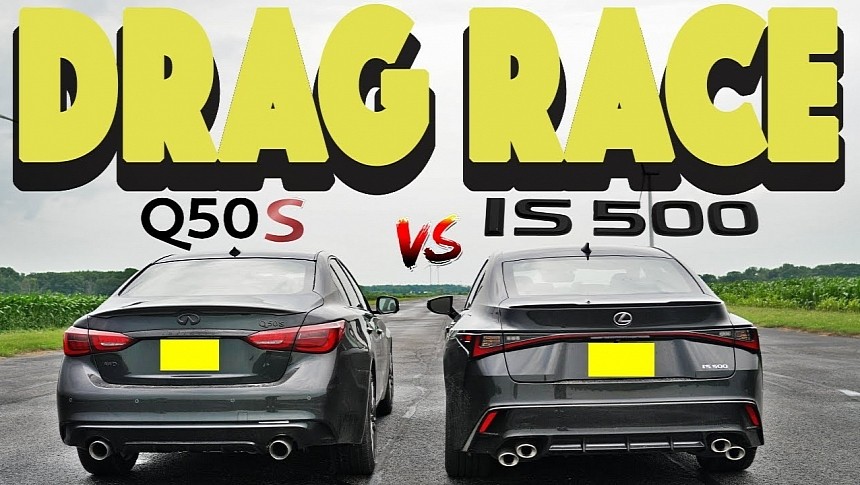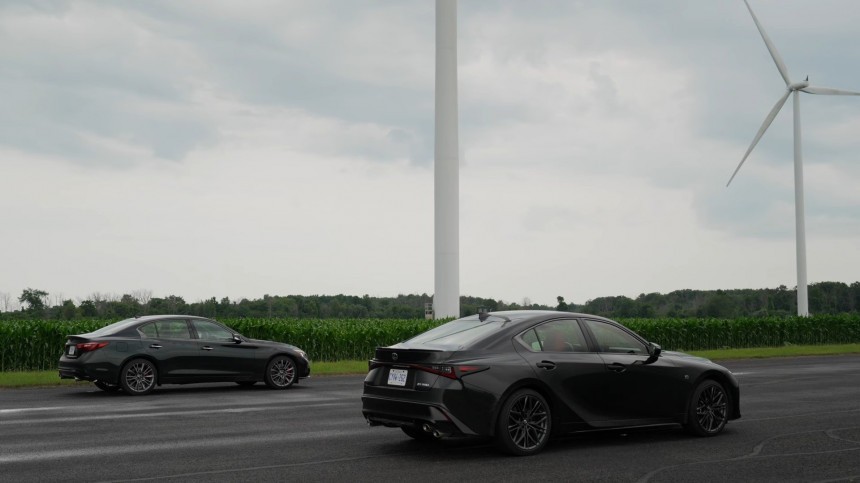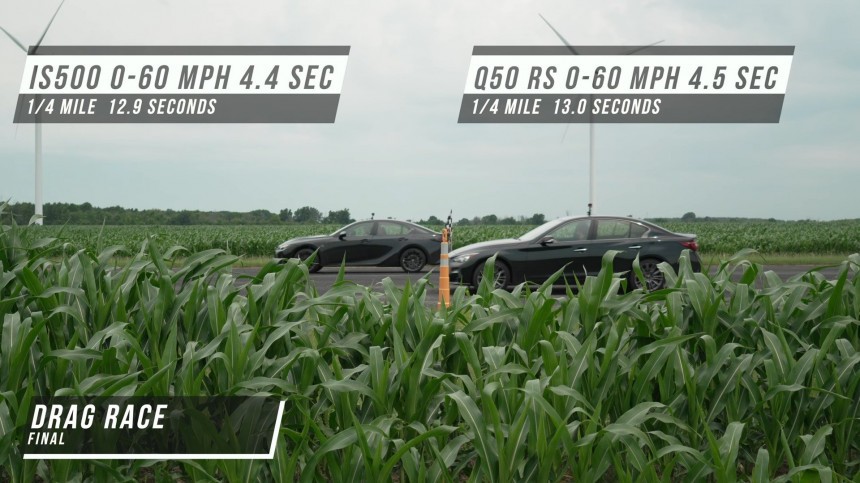With accelerated electrification being instituted far and wide in personal transportation devices, new releases of V8 music becomes rarer by the day. This is visible in the compact sedan category, where the trend of deserting hydrocarbons in favor of electrons pushes pistons into obsolescence.
The temporary refuge in turbo reservations – on the condition that cylinder count be kept below six – is a small and unfulfilling compensation for full-fledged nostalgia for the days when high-revving motors were the norm.
But evolution is merciless – the choice is to adapt or claim a spot in the history books, and V8s are going down. As of 2023, the only compact sedan that still offers a real-deal free-breathing eight-pot for the American market is a Japanese make – the Lexus IS 500. The Germans abandoned that creed years ago and now arm their small sedans with V6s and even inline-fours (loo
king at you, BMW and Mercedes-Benz, and your M340i and C43 AMG).
The de-pistonification plague has affected other Japanese carmakers – Infiniti, for example, dropped a pair of turbos to keep good company to the V6 under the hood of the Q50 Red Sport. But it’s like putting lipstick on a pig – no matter how much more efficient and emission-compliant the result is, it has the definitive effect of eradicating cubic fun.
Look at the video attached to this story – it’s a drag race between a V8 Lexus IS 500 and the Infiniti Q50 RS. It’s Toyota v Nissan, but we’re not talking Supra and GT-R here, but mundane four-door daily drivers with extra horsepower and torque stuffed under the hood.
Nonetheless, it could be attractive – at least, the paper gives some hope: the Lexus is a 5.0-liter naturally-aspirated V8 with 472 hp and 395 lb-ft (479 PS/536 Nm) reserved for the rear wheels via an eight-speed automatic.
The Infiniti has a three-liter V6 with a couple of screws strapped onto it. A rather dull equation involving displacement reduction balanced by a turbocharging multiplication factor yields the horsepower rating at 400 flat (405 PS) and a crank-twisting force of 350 lb-ft (475 Nm). Oddly enough, the pompous Nissan uses a seven-speed auto and puts the power down on all four corners.
This last detail usually means a competitive advantage for the AWD car – given that the power and weight fall within the same category. While the two cars featured in this video Sam Z. Xhepaj (better known by his YouTubing name of Sam Carlegion), are pretty much in the same weight range, the power is decisively in favor of the Lexus.
This is more than striking In the rolling start races, where the RWD Lexus IS 500 gaps the Infiniti Q50 RS easily. From 32 mph / 50 kph, the V8 has little effort to throw in the race to leave the twin-turbo V6 behind.
The first round is more dramatic, with the gearboxes allowed to shift at will. Thanks to its all-wheel-drive system, the Infiniti pulls ahead briefly but runs out of breath shortly. On the other hand, the naturally-aspirated V8 gets going at the top end, cracking the whip right below the redline to stay in the optimal powerband.
Interestingly, the standing quarter-mile contest is anyone’s guess – and the two cars share the wins equally. Admittedly, the Infinity takes the first round by less than half a car length after a hot pursuit race from the Lexus. The IS 500 gets a better start in the final game and stays neck and neck with its rival. The race is a close call for the first three-quarters of the 440-yard sprint, and the V8 takes the lead moments before the finish line.
One-tenth of a second separates the two cars in the 0-60 mph / 100 kph times and the 1,320-foot race. 4.4 and 4.5 (Lexus, Infiniti - in this order), and 12.9 and 13.0 – the numbers are about as exhilarating as the two cars’ overall design. Despite being 2023 models, we can easily see the styling cues from a decade ago, with only minor tweaks that can hardly hide the aging elephant in the room.
Granted, with the general adulation of touchscreens and ‘connected-ness,’ the Japanese sobriety of the IS 500 and Q50 RS make them about as high-techy as a crank-operated telephone (yes, this was an actual thing).
But evolution is merciless – the choice is to adapt or claim a spot in the history books, and V8s are going down. As of 2023, the only compact sedan that still offers a real-deal free-breathing eight-pot for the American market is a Japanese make – the Lexus IS 500. The Germans abandoned that creed years ago and now arm their small sedans with V6s and even inline-fours (loo
king at you, BMW and Mercedes-Benz, and your M340i and C43 AMG).
The de-pistonification plague has affected other Japanese carmakers – Infiniti, for example, dropped a pair of turbos to keep good company to the V6 under the hood of the Q50 Red Sport. But it’s like putting lipstick on a pig – no matter how much more efficient and emission-compliant the result is, it has the definitive effect of eradicating cubic fun.
Nonetheless, it could be attractive – at least, the paper gives some hope: the Lexus is a 5.0-liter naturally-aspirated V8 with 472 hp and 395 lb-ft (479 PS/536 Nm) reserved for the rear wheels via an eight-speed automatic.
The Infiniti has a three-liter V6 with a couple of screws strapped onto it. A rather dull equation involving displacement reduction balanced by a turbocharging multiplication factor yields the horsepower rating at 400 flat (405 PS) and a crank-twisting force of 350 lb-ft (475 Nm). Oddly enough, the pompous Nissan uses a seven-speed auto and puts the power down on all four corners.
This is more than striking In the rolling start races, where the RWD Lexus IS 500 gaps the Infiniti Q50 RS easily. From 32 mph / 50 kph, the V8 has little effort to throw in the race to leave the twin-turbo V6 behind.
The first round is more dramatic, with the gearboxes allowed to shift at will. Thanks to its all-wheel-drive system, the Infiniti pulls ahead briefly but runs out of breath shortly. On the other hand, the naturally-aspirated V8 gets going at the top end, cracking the whip right below the redline to stay in the optimal powerband.
One-tenth of a second separates the two cars in the 0-60 mph / 100 kph times and the 1,320-foot race. 4.4 and 4.5 (Lexus, Infiniti - in this order), and 12.9 and 13.0 – the numbers are about as exhilarating as the two cars’ overall design. Despite being 2023 models, we can easily see the styling cues from a decade ago, with only minor tweaks that can hardly hide the aging elephant in the room.
Granted, with the general adulation of touchscreens and ‘connected-ness,’ the Japanese sobriety of the IS 500 and Q50 RS make them about as high-techy as a crank-operated telephone (yes, this was an actual thing).

























